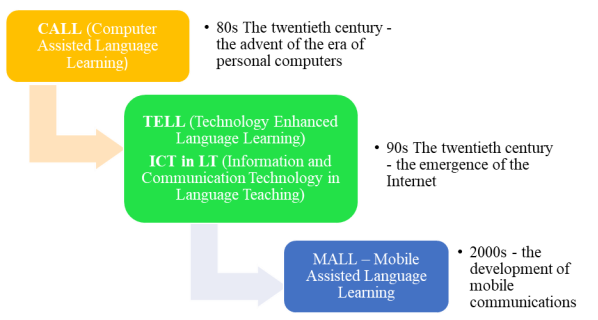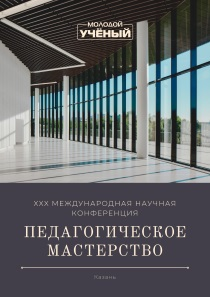Teaching foreign languages by using multimedia programs
Автор: Алтынбекова Ляззат Алтынбековна
Рубрика: 1. Общая педагогика
Опубликовано в
XXX международная научная конференция «Педагогическое мастерство» (Казань, май 2022)
Дата публикации: 31.05.2022
Статья просмотрена: 10 раз
Библиографическое описание:
Алтынбекова, Л. А. Teaching foreign languages by using multimedia programs / Л. А. Алтынбекова. — Текст : непосредственный // Педагогическое мастерство : материалы XXX Междунар. науч. конф. (г. Казань, май 2022 г.). — Казань : Молодой ученый, 2022. — С. 1-5. — URL: https://moluch.ru/conf/ped/archive/446/17246/ (дата обращения: 25.04.2024).
Leading experts in the field of language and intercultural communication consider language education as an important reserve of social and economic transformations in the country; the main tool for successful human life in a multicultural and multilingual community of people; factor of cultural and intellectual development and upbringing of a person with planetary thinking; note the need to bring language policy to the new realities of society, the importance of developing a new educational technology. In this regard, of particular interest is the problem of improving the quality of teaching a foreign language in the educational system of higher education. Both the content of education and the methods of teaching foreign languages are subject to change. [1,p.56]
Currently, information technology has become an integral part of our lives. Now it is almost impossible to find a sphere of human activity where part of the tasks would not be solved with the help of a computer and the Internet. The active use of information technology is also observed in the field of education.
Recent advances in high technology provide teachers with ample opportunities to improve the educational process and its transfer to a qualitatively new basis. Now it is possible to transmit information using various software and hardware tools that allow you to process information in sound and visual forms, that is, multimedia.
The use of multimedia technology plays a significant role in modern methods of teaching foreign languages. The use of electronic dictionaries, encyclopedias, interactive textbooks and manuals, games, Internet resources, simulators, electronic presentations, etc., allows to increase the efficiency of learning.
Traditionally, the process of learning a foreign language involves the transfer of theoretical information and the development of skills necessary for successful communication in the framework of the studied discipline. The use of multimedia can positively affect several aspects of the educational process. In the conditions of the classroom form of education, the teacher does not always have the opportunity to pay due attention to each student, which leads to a loss of motivation to learn and a decrease in the level of knowledge and skills. Multimedia can be used in the context of a wide variety of learning styles and is perceived by various people: some prefer to learn through reading, others through listening, and others through watching video.
The use of multimedia tools in the classroom in a foreign language allows to implement a personality-oriented approach, contributes to the individualization and differentiation of education, i.e., activates students' activities, increases interest in the subject and makes it possible to organize independent work of each student taking into account his age, psychological characteristics and level language proficiency. «By working with multimedia tools, students can influence their own learning process, adjusting it to their individual abilities and preferences. They study exactly the material that interests them, repeat the study as many times as they need, which contributes to a more correct perception» [2]
One of the main advantages of using multimedia tools is that they allow students to organize a variety of learning activities, providing various ways to expand vocabulary and get acquainted with new patterns of utterances, improve memorization of studied language constructions and interrelations between these constructs, and train certain skills.
Appealing in the classroom to audio and video materials (songs, educational films with different thematic focus, news programs, TV shows, commercials) also contributes to the diversity of students' learning activities and allows them to artificially create a language environment, immerse students in the realities of the reality of another country and thus, to form not only linguistic, but also sociocultural competence. Multimedia technologies allow the student to make not only the contemplator of the finished educational material, but also a participant in its creation, transformation, and operational use.
The teacher can carry out group and individual work with children, using learning programs with game elements. Mastering the language through the game is one of the basic principles of the learning system. A variety of multimedia games contribute to the expansion of vocabulary, familiar with the grammar of a foreign language, learn to understand speech by ear, to write correctly [3].
The active integration of technical equipment into the educational process dates back to the 1970s. XX century due to the widespread personal devices such as tape recorders and film projectors. However, soon more devices that are sophisticated are gradually replacing them, primarily a personal computer [4].
In the foreign scientific community since the mid-80s. The twentieth century, a new approach to learning foreign languages CALL Computer Assisted Language Learning (computer language learning). In the 90s. Due to the development of the Internet in the framework of CALL, different approaches emerge from the 20 th century: TELL (TechnologyEnhancedLanguageLearning technology enhanced language learning) and ICT in LT(Information and Communication Technology in Language Teaching — ICT in language teaching), reflecting the changes in high-tech — the emergence of the Internet and electronic communication. The emergence and development of mobile communications, which have become actively used in lingo didactics, led in turn to the emergence of the term MALL — Mobile Assisted Language Learning (learning a language using mobile communications) [4,5].

Fig. 1. The evolution of foreign language teaching approaches using technical means
«Computer linguodidactics» (proposed by KR R. Piotrovskaya) is, from the point of view of MA Bovtenko, the most adequate in terms of the comprehensiveness of the theoretical and practical aspects of the application of information technology in teaching a foreign language, as well as taking into account trends in the development of terminology in this scientific field. M. A. Bovtenko believes that this term may soon be superseded by the term «e-linguodidactics» due to the spread of information and communication technologies in teaching foreign languages and the expansion of a number of platforms through which (electronic) communication takes place [6].
It is necessary to mention that the introduction of multimedia technologies in the educational process can be both positive (contribute to the effectiveness of training) and negative in nature (with the use of multimedia tools). It is obvious that the solution of the problems of appropriate and justifiable informatization of education should be carried out comprehensively. There are two possible directions for the introduction of multimedia in the educational process. The first of these is related to the fact that «such funds are included in the educational process as «supporting» means within the framework of traditional methods of the education system» [7]. In this case, multimedia resources act as a means of intensifying the educational process, individualizing education and partial automation of the work of teachers related to accounting, measurement and evaluation of students' knowledge.
It should also be emphasized that for each multimedia program a methodological note should be drawn up, which indicates which audience the program is designed for, the types of skills that are developed with its help, the educational material it is based on, the number of hours it is calculated, the place given programs in the educational process, etc., that is, «the program must have a scenario for use for the possibility of its use by other teachers» [8].
So, the process of learning a foreign language is a complex, constantly evolving system. Therefore, teachers need to use in their work the opportunities that appear in the modern world. To date, they are multimedia. They are effective educational technologies due to their inherent qualities of interactivity, flexibility and integration of various types of educational information, as well as the ability to take into account the individual characteristics of students and to increase their motivation.
References:
- Kunanbayeva S. S. Modern foreign language education: methodology and theories. — Almaty, 2005. — P.51–67.
- Nasibullin E. N. On the effectiveness of information technology training.-2005
- Efremenko V. A. The use of information technology in foreign language lessons // Foreign languages at school. — 2007. P.18–21.
- Sarycheva L. V. Features of teaching a foreign language in the conditions of the new paradigm of education // 2014.c.160.
- Kolesnikova I. L., Dolgina O. A. English-Russian terminological reference book on the methodology of teaching foreign languages: a reference guide, 2008. 431 c.
- Bovtenko MA, Gartsov AD, Elnikova. Computational linguodidactics: theory and practice: a course of lectures. — Moscow: Publishing House of the Peoples' Friendship University of Russia, 2006. — 211 p.
- The use of multimedia technologies in general secondary education / Institute of Distant Education of the Russian University of Peoples Friendship, 2006.
- Ovsisher G. M., Ovsisher M. V. Internet and education: first steps // Strategies for teaching English: theory and practice. Samara, 2001.











